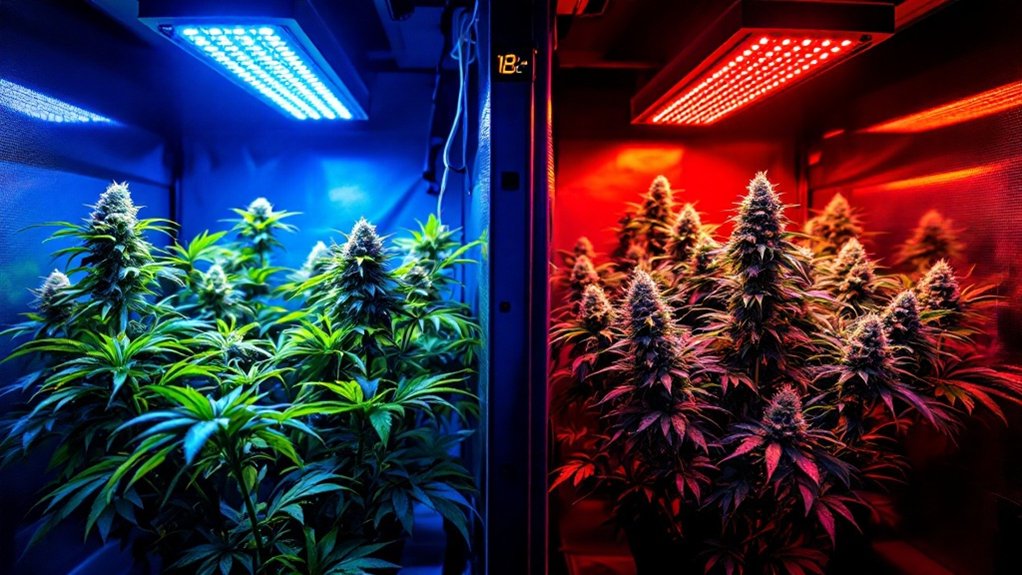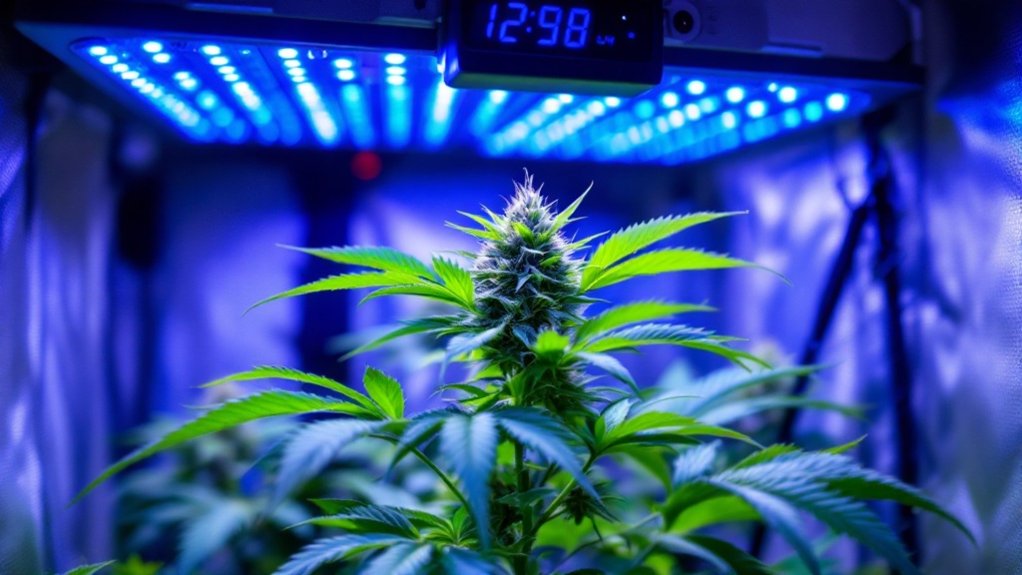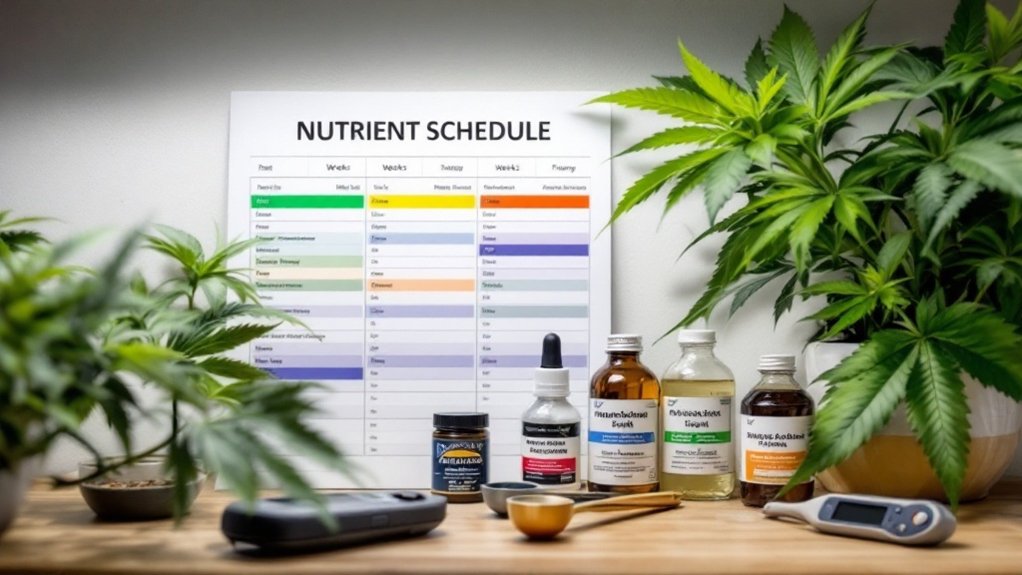Cannabis plants require specific light schedules to thrive: 18/6 (18 hours light, 6 hours dark) for vegetative growth and 12/12 for flowering. Blue spectrum lights optimize the vegetative stage lasting 4-7 weeks, while red wavelengths benefit flowering. Autoflowering strains follow different rules, thriving under consistent 18-24 hours of daily light regardless of growth stage. Avoiding light leaks and maintaining consistent timing prevents stress and maximizes yield potential.

When growing cannabis, understanding the proper light schedule is essential for ensuring ideal plant development and maximum yield potential. Cannabis plants are photoperiod-sensitive, meaning their growth and flowering stages are controlled by the duration of light exposure they receive daily. Light schedules are typically expressed as fractions, with the first number representing hours of light and the second indicating hours of darkness within a 24-hour cycle.
During the vegetative stage, cannabis plants require abundant light to develop strong stems, healthy foliage, and extensive root systems. The standard vegetative light schedule maintains 18 hours of light and 6 hours of darkness (18/6), though some growers implement a full 24 hours of light (24/0). This extended daylight period prevents the plant from entering its flowering phase prematurely. Proper lighting can significantly enhance plant growth and overall health during this critical phase.
Blue-spectrum lighting proves most effective during this 4-7 week vegetative period, promoting robust structural development before shifting to the flowering stage. For advanced cultivators, data-driven cultivation systems can monitor and adjust lighting conditions based on plant response metrics.
Flowering begins when cannabis plants receive 12 hours of uninterrupted darkness daily, mimicking the shorter days of late summer and early fall. This 12/12 light cycle triggers hormonal changes that redirect the plant’s energy from vegetative growth toward bud production. Plants typically double in size during the flowering stage, which is why height management before this transition is crucial. The spectrum should shift toward red wavelengths during flowering to optimize bud development.
Visible flowers typically appear approximately two weeks after implementing the 12/12 schedule, with mature buds forming by the fourth week of flowering.
Autoflowering cannabis strains present an exception to these light scheduling requirements. These varieties begin flowering based on age rather than light cycle changes, allowing them to thrive under consistent light schedules of 18-24 hours daily throughout their entire lifecycle. This characteristic makes autoflowering strains particularly suitable for novice growers seeking simplified light management.
Proper equipment is essential for maintaining consistent light schedules. Reliable LED grow lights, accurate timers, and light-proof growing environments prevent schedule disruptions that can stress plants.
Common mistakes include light leaks during dark periods, inconsistent timing, and improper spectrum selection for different growth stages. Outdoor growers face additional challenges, as they must work with natural daylight cycles or implement light deprivation techniques to control flowering timing.
With careful attention to light scheduling, cannabis cultivators can optimize plant development, increase yield potential, and produce high-quality harvests through each growing cycle.
Frequently Asked Questions
How Does Light Spectrum Affect Cannabis Yield?
Light spectrum considerably impacts cannabis morphology and cannabinoid production while influencing flowering prolificacy.
Various wavelengths trigger distinct plant responses, with some spectra enhancing THC concentrations despite maintaining similar overall yields. Research indicates that different cannabis strains exhibit unique responses to identical light spectra, suggesting genetic interactions with light quality.
Although spectrum manipulation presents optimization opportunities for cultivators, studies consistently demonstrate that light intensity remains more reliably impactful on total yield than spectral modifications alone.
Can I Use Household LED Bulbs for Growing Cannabis?
Household LED bulbs are generally inadequate for cannabis cultivation. They lack the necessary light intensity (400-1000 µmol/m²/s) and specific spectrum required for ideal growth, particularly during flowering stages.
Standard LEDs produce insufficient blue (400-500 nm) and red (600-700 nm) wavelengths critical for cannabis development. While seedlings might survive briefly under household LEDs, mature plants will exhibit leggy growth, reduced yields, and diminished cannabinoid production.
Dedicated cannabis grow lights offer superior efficiency and targeted spectrum for proper plant development.
What’s the Minimum Light Wattage Needed per Cannabis Plant?
The minimum light wattage needed depends on the cannabis plant’s growth stage and available space.
For a single plant, approximately 120W of LED lighting is recommended to cover a 0.5m² area.
During vegetative growth, plants require about 20 watts per square foot, while flowering demands 30 watts per square foot.
Light intensity diminishes considerably with distance, following the inverse square law, making proper positioning essential for ideal growth.
Do Autoflowering Strains Require Different Light Schedules?
Autoflowering cannabis strains do require different light schedules than photoperiod varieties.
Unlike photoperiod plants that need light cycle changes to trigger flowering, autoflowers will flower based on age regardless of light duration.
Most cultivators utilize 18/6, 20/4, or 24/0 light schedules for autoflowers throughout their entire lifecycle.
The 20/4 schedule is particularly popular as it balances maximized growth with a short rest period, potentially leading to higher yields and increased resin production.
How Do Light Stress Training Techniques Impact Flowering Times?
Light stress training techniques generally do not directly impact flowering times, but they can optimize plant development during this phase.
When implemented properly around the third week of flowering, LST improves light distribution to all plant parts, potentially increasing yields by 50% or more.
Environmental stressors like light leaks or excessive light hours may delay flowering, while controlled temperature drops near harvest can enhance coloration and potency without affecting the overall timeline.









